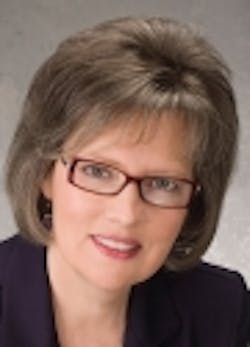Similar lesions, yet only one is benign
The dental clinician often observes a lesion in the mouth with undetermined causes and becomes an investigator when trying to solve the mystery. The diagnosis may be a benign lesion or, in some cases, can be a more serious concern. This month's column discusses two separate cases, within the same practice just weeks apart, presenting with similar clinical appearances but with a very different diagnosis in each case.
The clinician's role becomes extremely important in gathering the needed information from the patient to determine a course of action. Are you asking the correct questions that will lead you to determine the best treatment for your patient?
Case 1: A healthy 35-year-old male visits the dental office for a routine exam and prophylaxis. During this visit he receives his annual cancer screening. The right lateral border of the tongue and floor of the mouth have noticeable, coalescing, diffuse white patches. When questioned regarding the etiology of alcohol and tobacco, the patient denies any use. He is also asked about habits regarding the etiology of the lesions that are painless, nonulcerated, and nonindurated (Figure 1).
The patient is unaware of the patches and cannot state how long they have been present. He is unable to provide any insight regarding trauma to the area.
Because of the unknown etiology, the patient is referred to an oral surgeon for a biopsy. Two weeks later, the surgeon calls the referring office and states that the patient presented to his office with no signs of any white lesions.
When the patient was questioned by the oral surgeon, he stated that he thought about it and believed that eating sunflower seeds and cracking the seeds with his teeth may have caused the lesions. He ceased the consumption of the seeds and the tissue returned to normal by the time he was examined by the oral surgeon. The sunflower seed consumption did not come up in conversation initially with the dentist or the hygienist at the general dentist's office.
Giving the patient possible cues with regard to trauma may be helpful since patients often become highly concerned when given the prospect of having any abnormality, or, in a worse-case scenario, cancer. Patients suffer a type of thought/process blockage when given any concern for abnormality or health problems. After having time to retrace his daily events, the patient was able to work through possible causes on his own. However, the dentist was astute in referring the patient for a biopsy when no cause could be determined initially.
Possible causes of trauma include:
- Morsicatio buccarum – cheek chewing
- Morsicatio labiorum – lip chewing
- Traumatic ulcer – sharp foods such as chips, rough foods, trauma to the tissues causing damage/ulcerations.
- Factitial injuries – Habits conducted by the patient such as lip biting and possible trauma due to objects inserted into the mouth such as combs, fingernail injury, etc. often produce a tissue injury.
- Iatrogenic injury – A tissue injury caused, for example, from a bur during a dental procedure or injury from a saliva ejector pressing on the tissue.
Case 2: A healthy 35-year-old female presents with white painless leukoplakia on the left lateral border and ventral surface of the tongue as well as the floor of the mouth (Figure 2). The patient tells you that the white areas have been present for approximately two weeks. After being treated by the hygienist and stating that the lesions cause pain, she is subsequently examined by the dentist. The doctor, however, is told no pain is experienced but that a strange feeling is noted in these areas.
The female is a regular maintenance patient who has had cancer screenings during past visits and reports no pre-existing condition or habits that would warrant any concern. Her personal history includes the recent death of her mother due to cancer. She reports that she is concerned that she may also have cancer. The patient is a young mother of two and has been busy caring for her children and dealing with the emotional trauma of her mother's death.
After being referred to an oral surgeon, a biopsy was performed with a diagnosis of squamous cell carcinoma in situ. She was referred to an oral surgery oncologist. Surgery was performed and a follow-up biopsy was made, which is now negative.
Conclusions: Lesions that have similar clinical appearances may have very different etiologies and diagnoses. The astute clinician must gain personal information from the patient so that a differential diagnosis can be made. In the two cases presented here, one was a benign lesion and the other was a far more serious diagnosis of cancer.
When an etiology cannot be determined, it is a far better idea to refer the patient for a biopsy, which is the gold standard, to determine the histology and diagnosis of the lesion. In the case involving the sunflower seeds, the patient was able to determine the cause on his own during the interim while waiting for his biopsy date.
After discontinuing the sunflower seeds, the lesions subsided and further treatment was not needed.
An additional point that should be reinforced is the fact that both of these patients were from the same practice and both appearing for their six-month recall visits just two weeks apart. Within the time frame of six months, they both had tissue changes that occurred. If the patient who developed squamous cell in situ had been seen later, the outcome may have been much worse. As a side note, if the oral cancer screening exam had not been performed, an additional amount of time would probably have passed, allowing the lesions to progress to a stage 1 status or beyond. Cancerous lesions in the floor of the mouth are very serious and have a much higher rate of mortality because of the rich blood supply found in the tissues. The importance of oral exams cannot be stressed enough.
Dr. Kathryn Jendrasik-Savitsky, who contributed the photos appearing in this column, practices dentistry in Charlotte, N.C.
Both patients were also examined by two hygienists, employed by Dr. Savitsky during maintenance appointments. They are Jessica Huffman, RDH, and Jennifer Richardson, RDH. Kudos to you all for the fine work you provide, and thanks for sharing these cases with me for my column.
Finally, keep asking good questions and always listen to your patients.
Nancy W. Burkhart, BSDH, EdD, is an adjunct associate professor in the department of periodontics, Baylor College of Dentistry and the Texas A & M Health Science Center, Dallas. Dr. Burkhart is founder and cohost of the International Oral Lichen Planus Support Group http://www.bcd.tamhsc.edu/outreach/lichen/ and coauthor of General and Oral Pathology for the Dental Hygienist. Her Web site for seminars is www.nancywburkhart.com.



